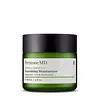What's inside
What's inside
 Key Ingredients
Key Ingredients

 Benefits
Benefits

 Concerns
Concerns

 Ingredients Side-by-side
Ingredients Side-by-side

Water
Skin ConditioningCaprylic/Capric Triglyceride
MaskingPEG-8 Dimethicone
EmulsifyingGlycerin
HumectantDimethicone
EmollientSimmondsia Chinensis Seed Oil
EmollientCetyl Alcohol
EmollientGlyceryl Stearate
EmollientC12-15 Alkyl Benzoate
AntimicrobialButyrospermum Parkii Butter
Skin ConditioningEthoxydiglycol
HumectantSqualane
EmollientPalmitoyl Hexapeptide-12
Skin ConditioningPanthenol
Skin ConditioningEctoin
Skin ConditioningPhospholipids
Skin ConditioningHydrolyzed Sericin
Skin ConditioningAllantoin
Skin ConditioningXanthan Gum
EmulsifyingOlea Europaea Leaf Extract
PerfumingAloe Barbadensis Leaf Juice
Skin ConditioningStearyl Glycyrrhetinate
Skin ConditioningCeramide Ng
Skin ConditioningTocotrienols
Skin ConditioningTocopherol
AntioxidantAmmonium Acryloyldimethyltaurate/Vp Copolymer
PEG-75 Stearate
Benzyl Alcohol
PerfumingTribehenin
EmollientCeteth-20
CleansingSteareth-20
CleansingButylene Glycol
HumectantPEG-10 Rapeseed Sterol
CleansingElaeis Guineensis Oil
EmollientDehydroacetic Acid
PreservativeWater, Caprylic/Capric Triglyceride, PEG-8 Dimethicone, Glycerin, Dimethicone, Simmondsia Chinensis Seed Oil, Cetyl Alcohol, Glyceryl Stearate, C12-15 Alkyl Benzoate, Butyrospermum Parkii Butter, Ethoxydiglycol, Squalane, Palmitoyl Hexapeptide-12, Panthenol, Ectoin, Phospholipids, Hydrolyzed Sericin, Allantoin, Xanthan Gum, Olea Europaea Leaf Extract, Aloe Barbadensis Leaf Juice, Stearyl Glycyrrhetinate, Ceramide Ng, Tocotrienols, Tocopherol, Ammonium Acryloyldimethyltaurate/Vp Copolymer, PEG-75 Stearate, Benzyl Alcohol, Tribehenin, Ceteth-20, Steareth-20, Butylene Glycol, PEG-10 Rapeseed Sterol, Elaeis Guineensis Oil, Dehydroacetic Acid
Water
Skin ConditioningDimethicone
EmollientGlycerin
HumectantTapioca Starch
Dimethicone Crosspolymer
Emulsion StabilisingRetinol
Skin ConditioningRetinyl Propionate
Skin ConditioningNiacinamide
SmoothingTropaeolum Majus Flower/Leaf/Stem Extract
Skin ConditioningPalmitoyl Pentapeptide-4
Skin ConditioningDimethiconol
EmollientLaureth-4
EmulsifyingPolysorbate 20
EmulsifyingLaureth-7
EmulsifyingDisodium EDTA
Polyacrylamide
Acrylates/C10-30 Alkyl Acrylate Crosspolymer
Emulsion StabilisingAminomethyl Propanol
BufferingPolymethylsilsesquioxane
Titanium Dioxide
Cosmetic ColorantC13-14 Isoparaffin
EmollientDMDM Hydantoin
PreservativeIodopropynyl Butylcarbamate
PreservativePlant Ash Extract
Avena Sativa Peptide
Skin ConditioningWater, Dimethicone, Glycerin, Tapioca Starch, Dimethicone Crosspolymer, Retinol, Retinyl Propionate, Niacinamide, Tropaeolum Majus Flower/Leaf/Stem Extract, Palmitoyl Pentapeptide-4, Dimethiconol, Laureth-4, Polysorbate 20, Laureth-7, Disodium EDTA, Polyacrylamide, Acrylates/C10-30 Alkyl Acrylate Crosspolymer, Aminomethyl Propanol, Polymethylsilsesquioxane, Titanium Dioxide, C13-14 Isoparaffin, DMDM Hydantoin, Iodopropynyl Butylcarbamate, Plant Ash Extract, Avena Sativa Peptide
 Reviews
Reviews

Ingredients Explained
These ingredients are found in both products.
Ingredients higher up in an ingredient list are typically present in a larger amount.
Dimethicone is a type of synthetic silicone created from natural materials such as quartz.
What it does:
Dimethicone comes in different viscosities:
Depending on the viscosity, dimethicone has different properties.
Ingredients lists don't always show which type is used, so we recommend reaching out to the brand if you have questions about the viscosity.
This ingredient is unlikely to cause irritation because it does not get absorbed into skin. However, people with silicone allergies should be careful about using this ingredient.
Note: Dimethicone may contribute to pilling. This is because it is not oil or water soluble, so pilling may occur when layered with products. When mixed with heavy oils in a formula, the outcome is also quite greasy.
Learn more about DimethiconeGlycerin is already naturally found in your skin. It helps moisturize and protect your skin.
A study from 2016 found glycerin to be more effective as a humectant than AHAs and hyaluronic acid.
As a humectant, it helps the skin stay hydrated by pulling moisture to your skin. The low molecular weight of glycerin allows it to pull moisture into the deeper layers of your skin.
Hydrated skin improves your skin barrier; Your skin barrier helps protect against irritants and bacteria.
Glycerin has also been found to have antimicrobial and antiviral properties. Due to these properties, glycerin is often used in wound and burn treatments.
In cosmetics, glycerin is usually derived from plants such as soybean or palm. However, it can also be sourced from animals, such as tallow or animal fat.
This ingredient is organic, colorless, odorless, and non-toxic.
Glycerin is the name for this ingredient in American English. British English uses Glycerol/Glycerine.
Learn more about GlycerinWater. It's the most common cosmetic ingredient of all. You'll usually see it at the top of ingredient lists, meaning that it makes up the largest part of the product.
So why is it so popular? Water most often acts as a solvent - this means that it helps dissolve other ingredients into the formulation.
You'll also recognize water as that liquid we all need to stay alive. If you see this, drink a glass of water. Stay hydrated!
Learn more about Water